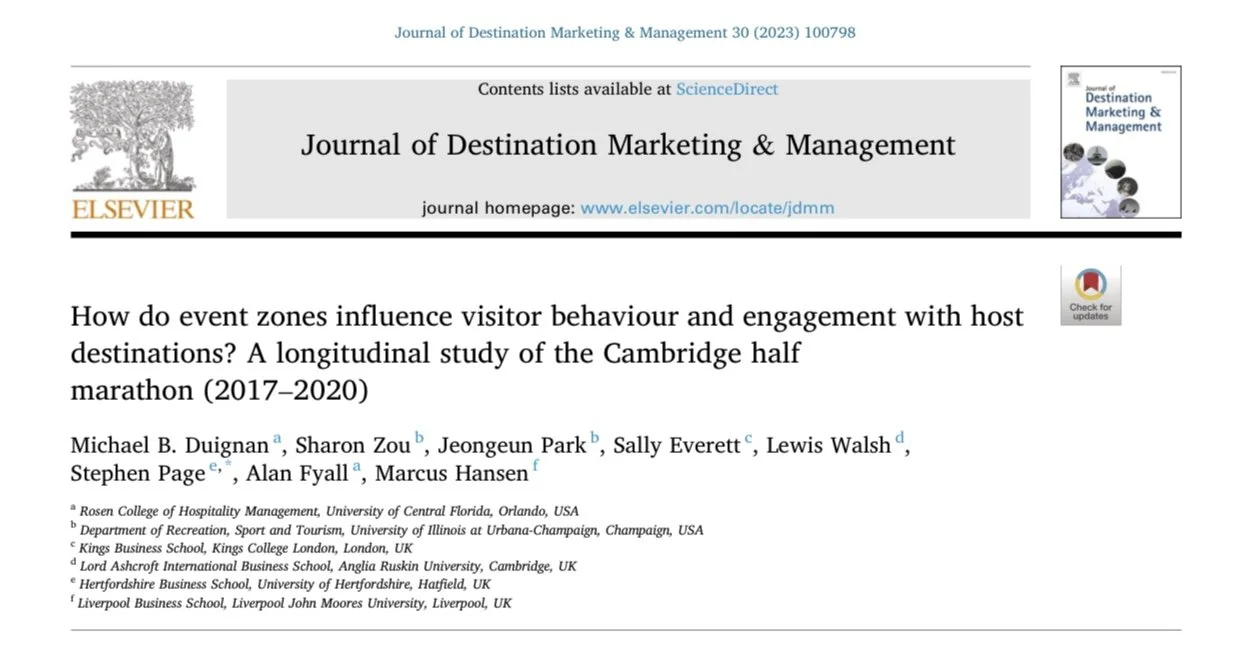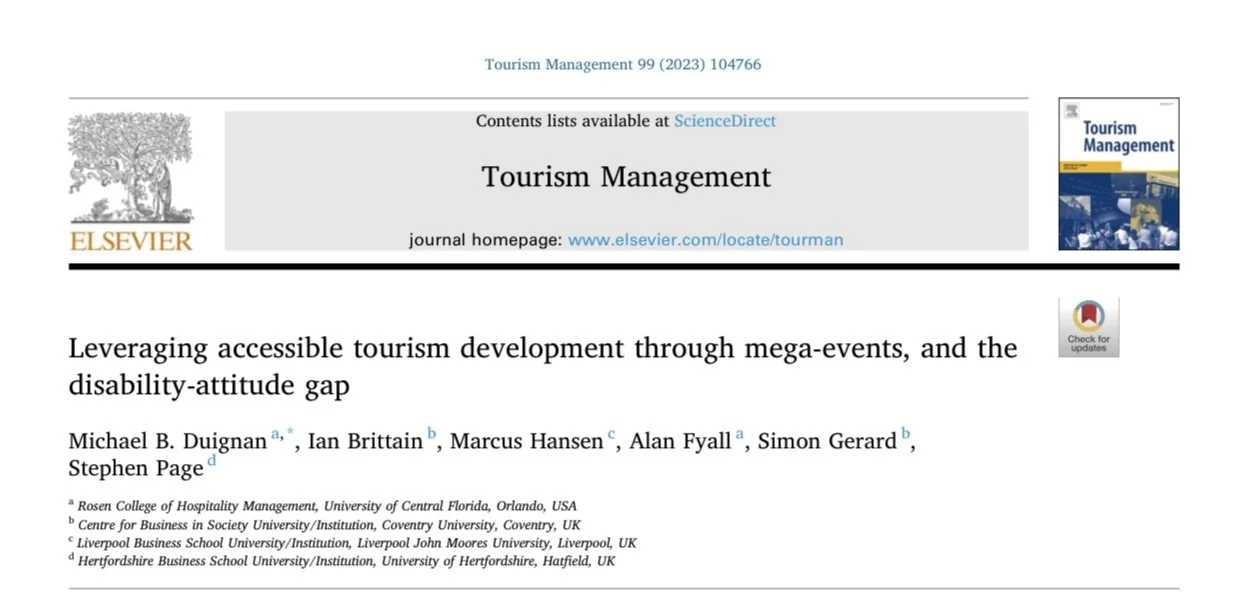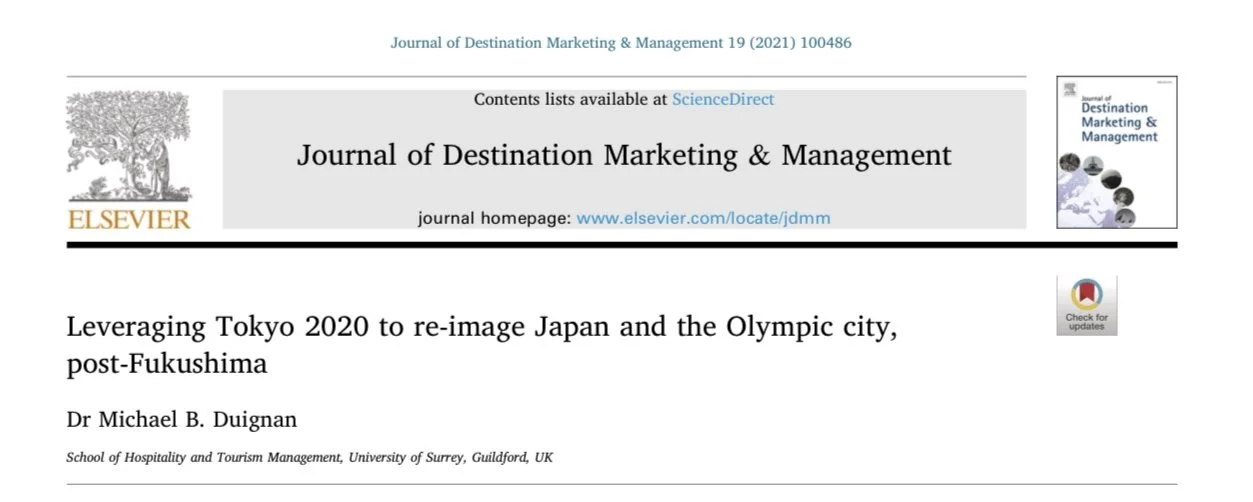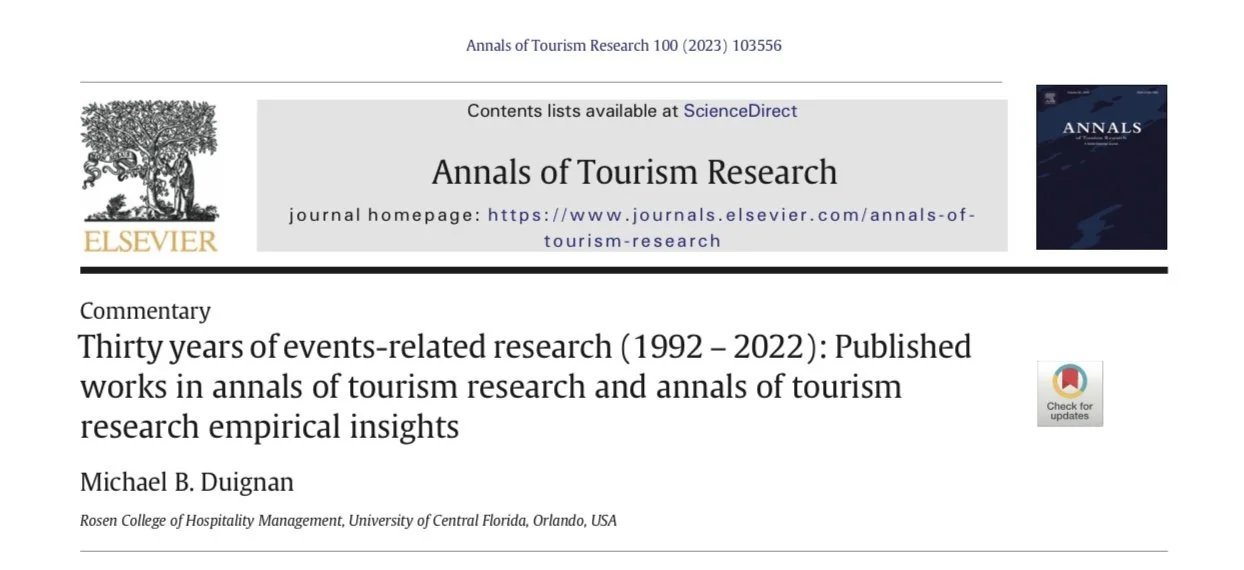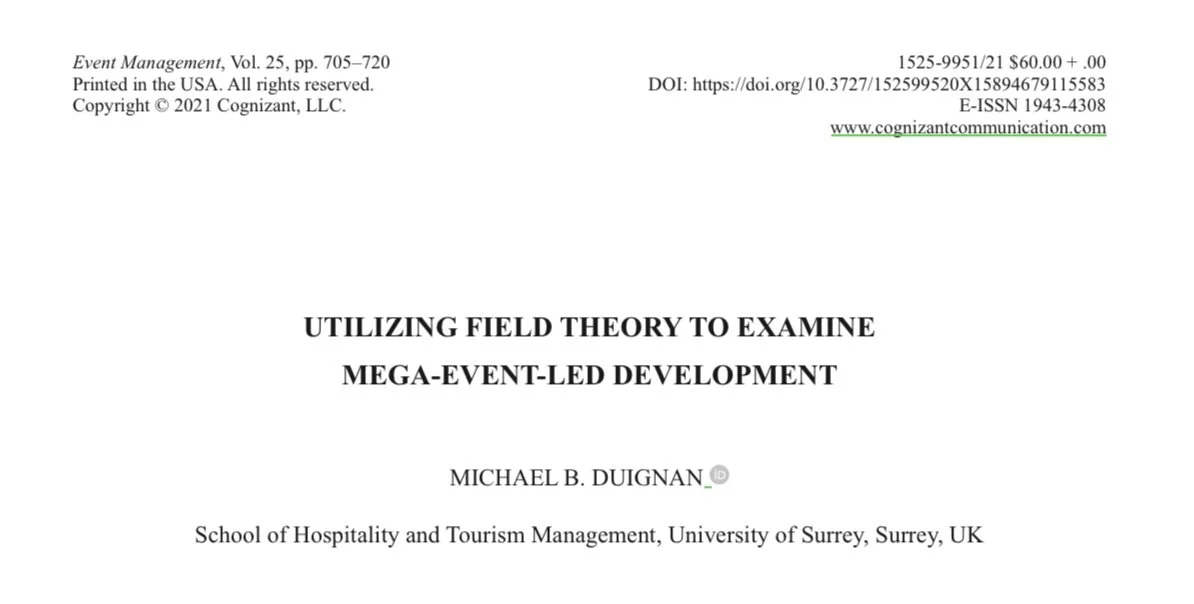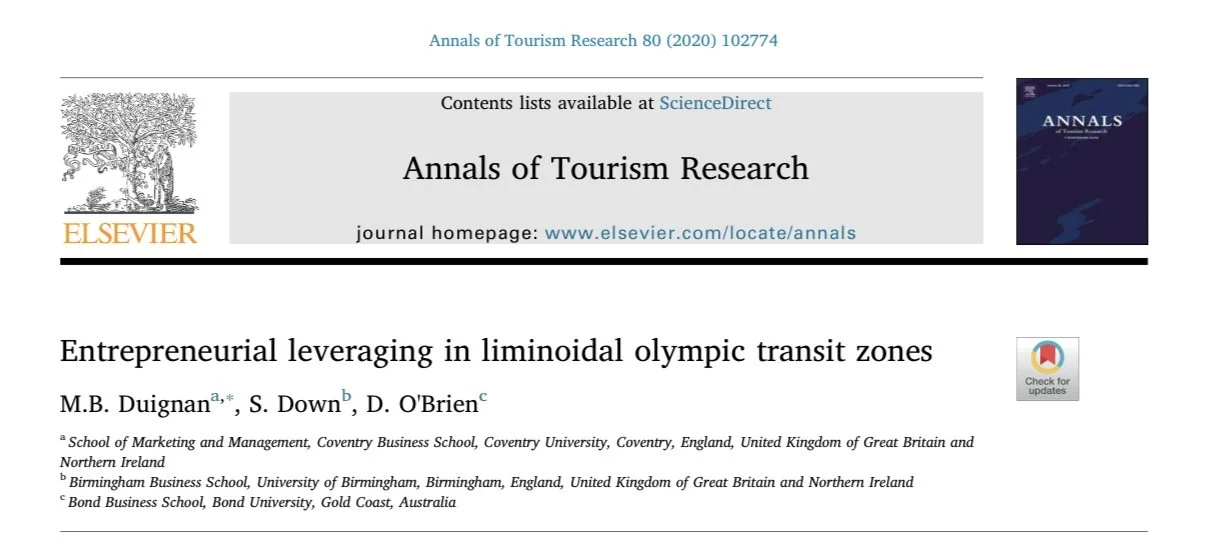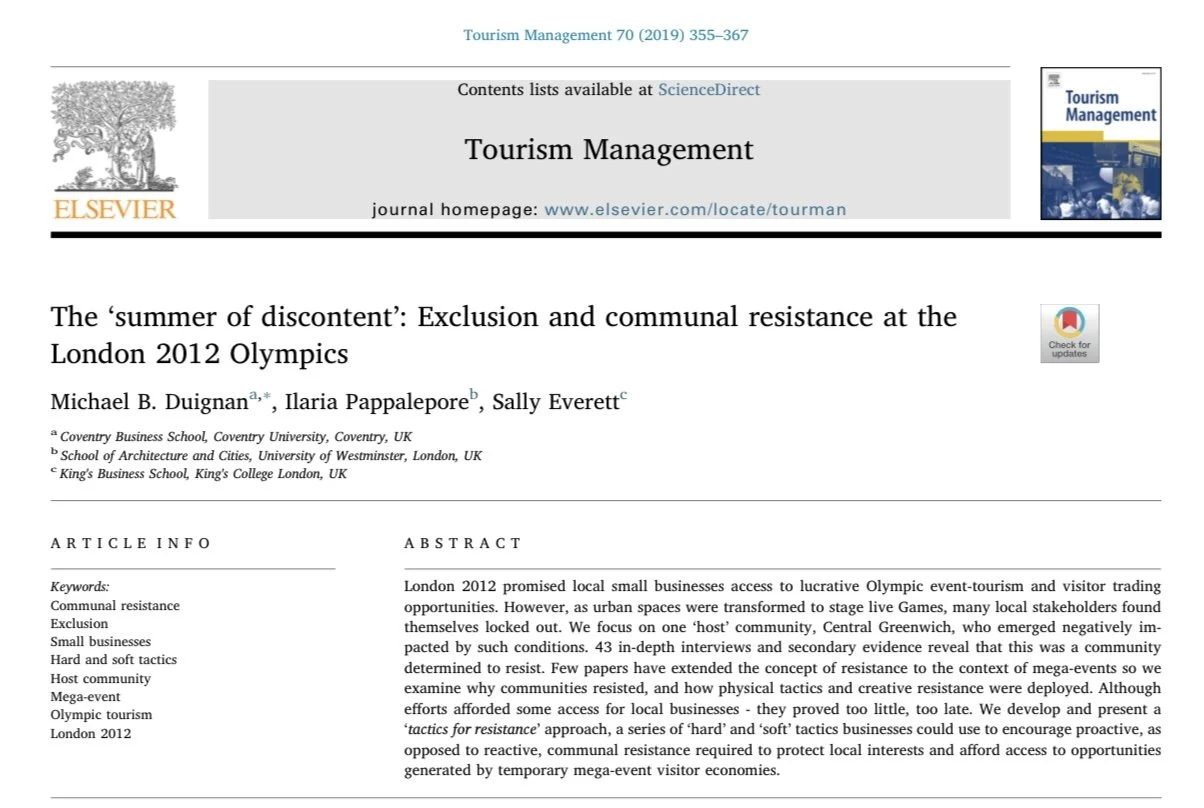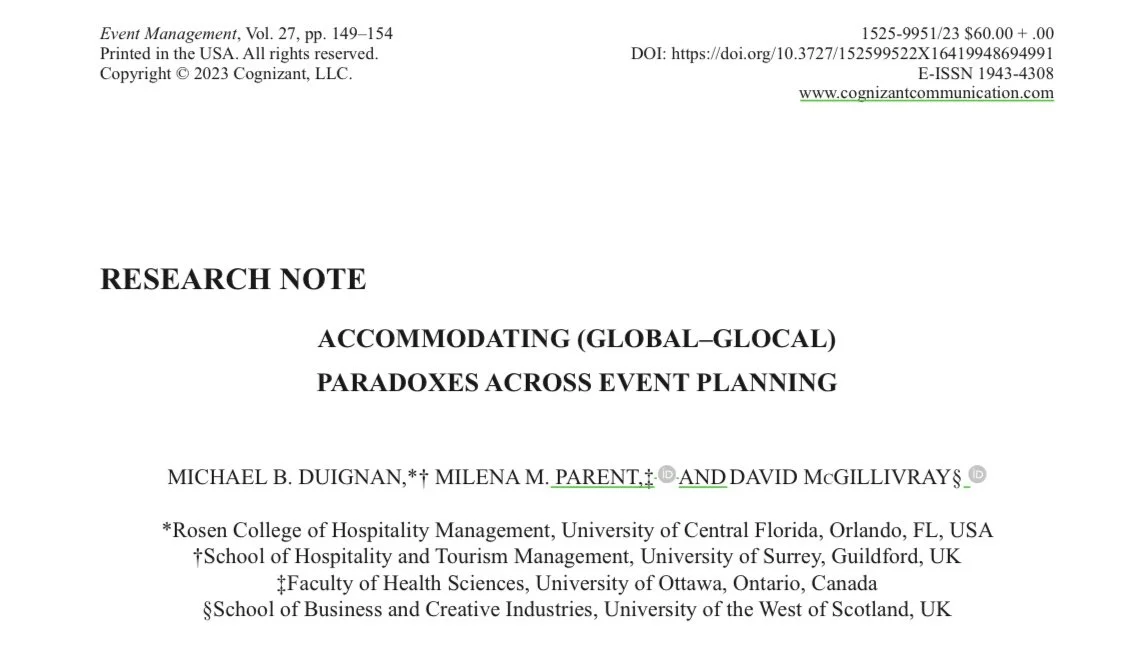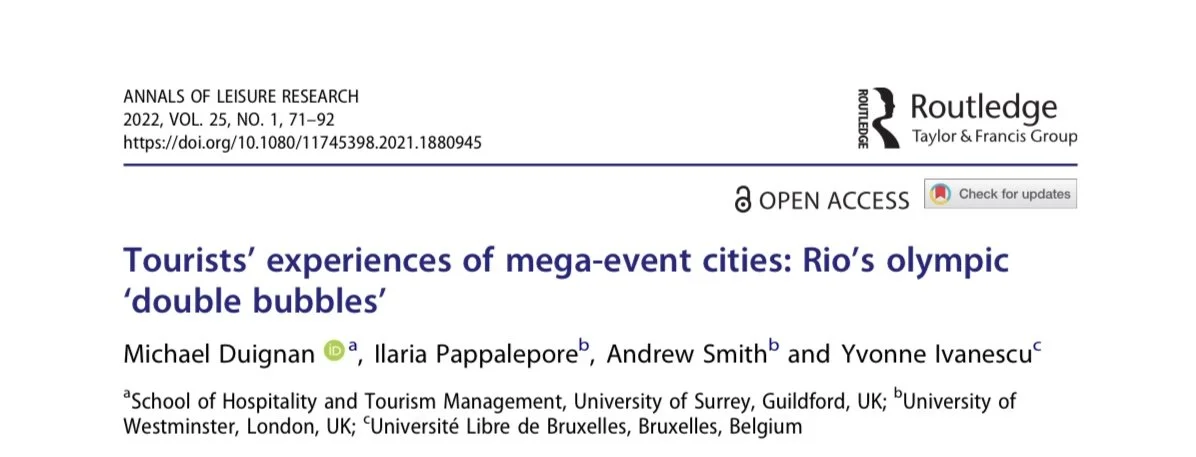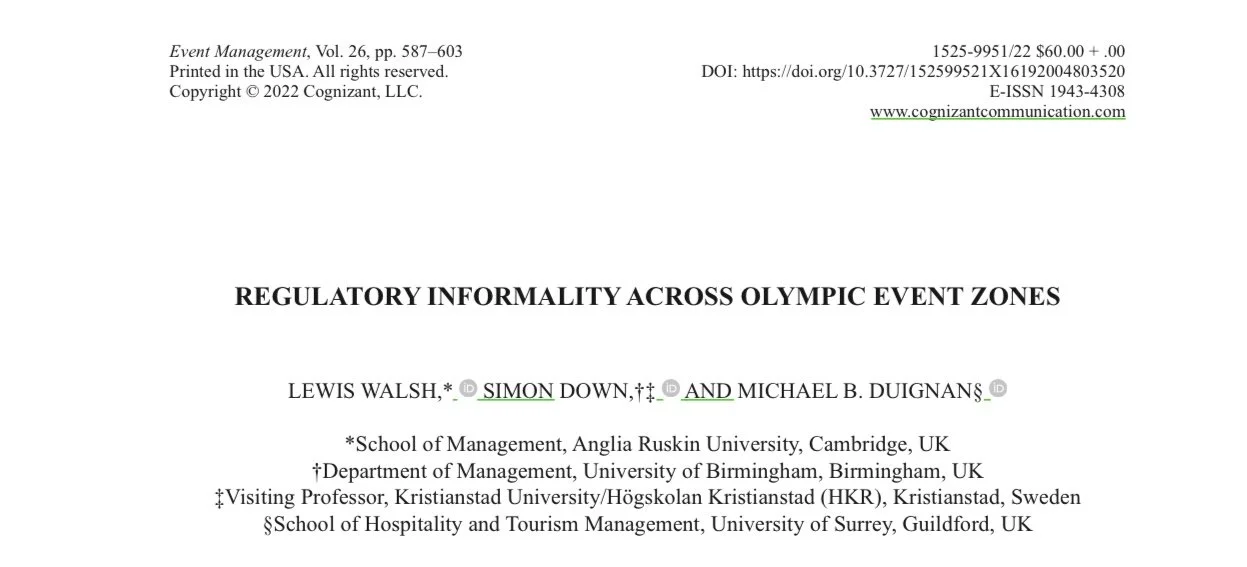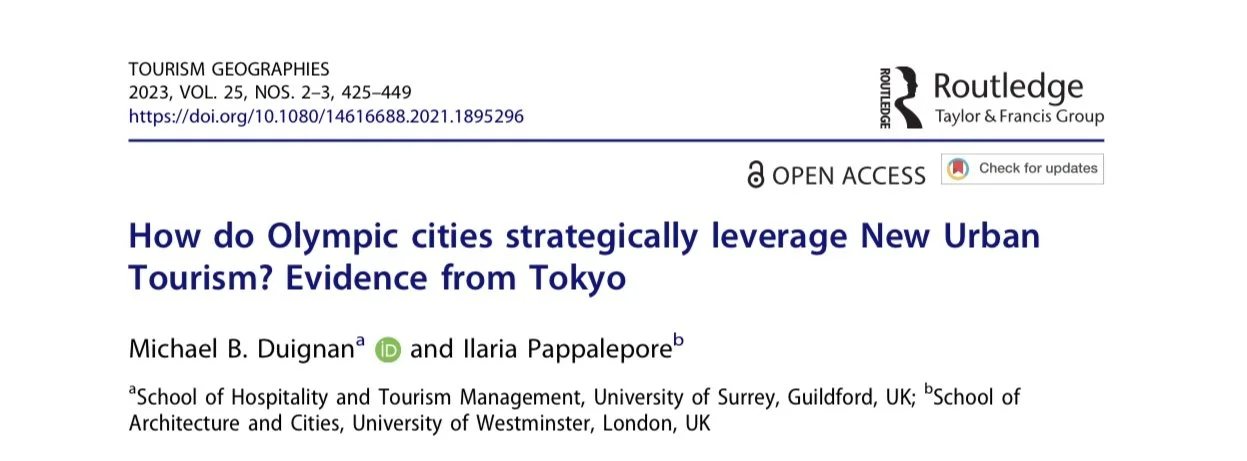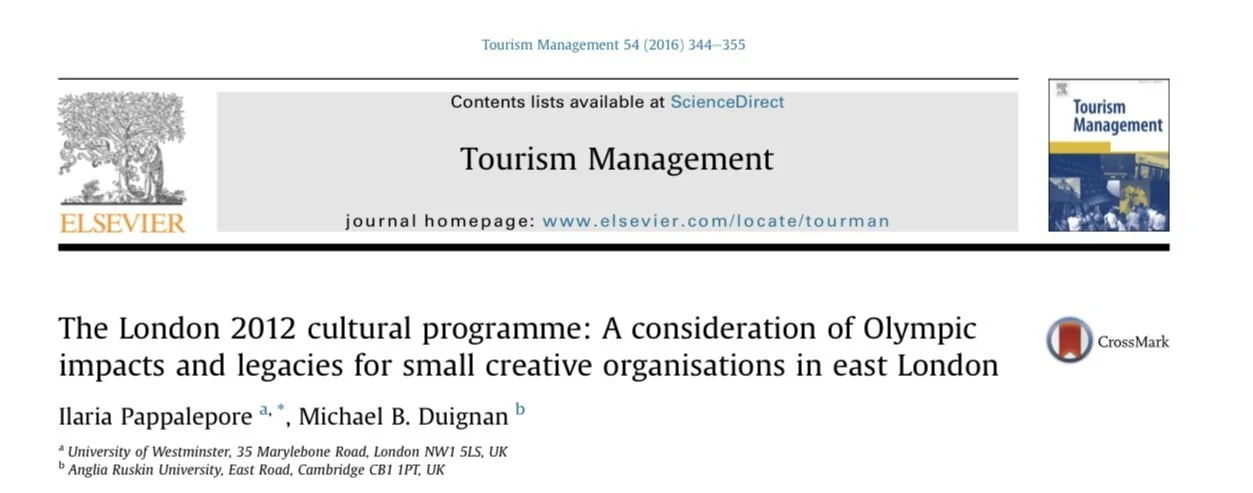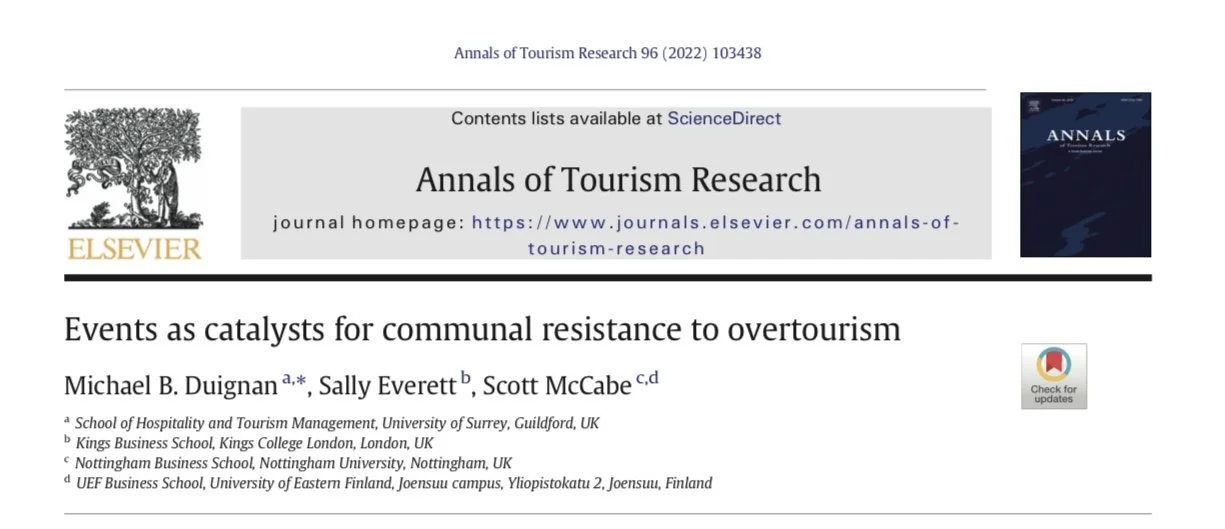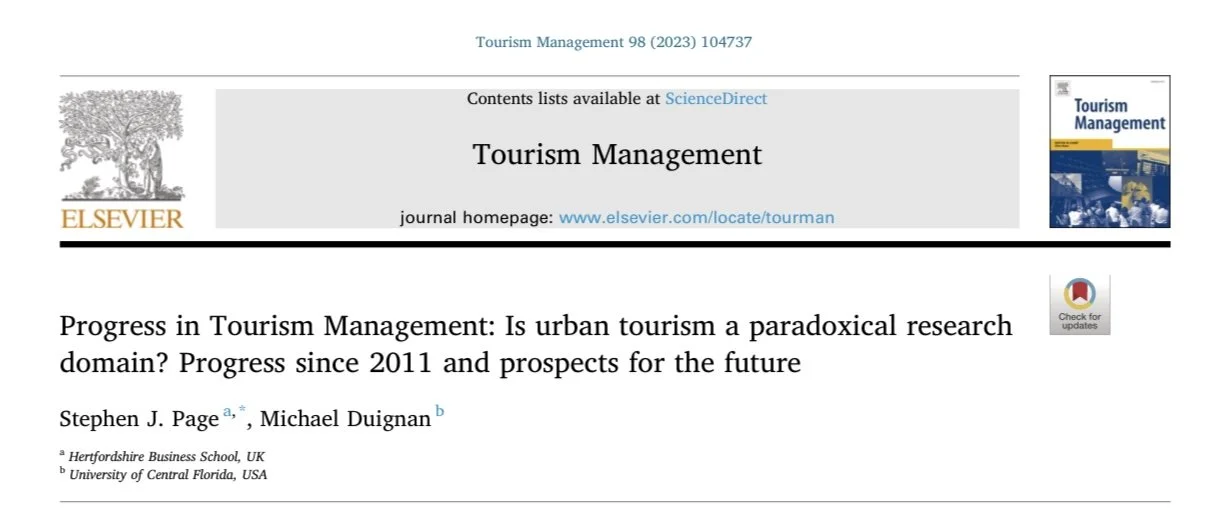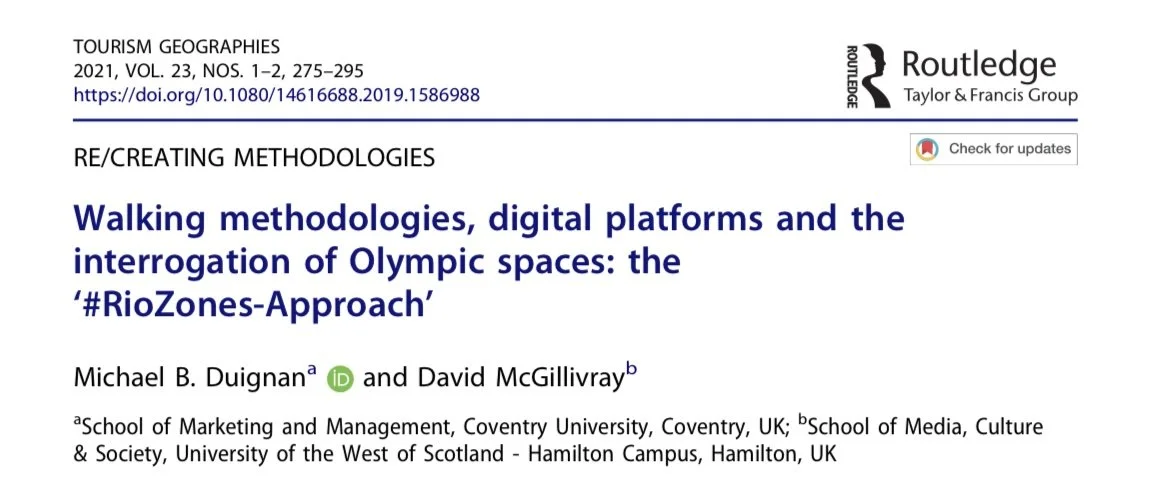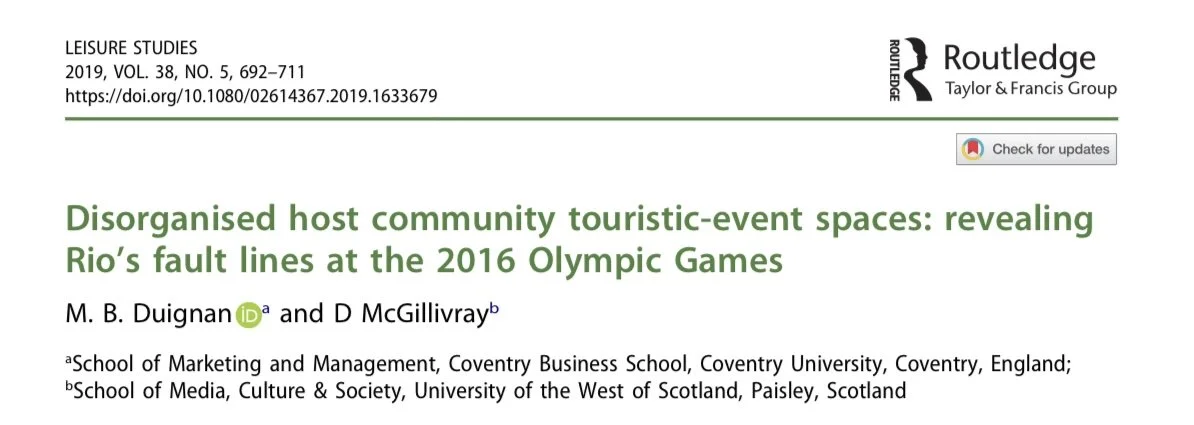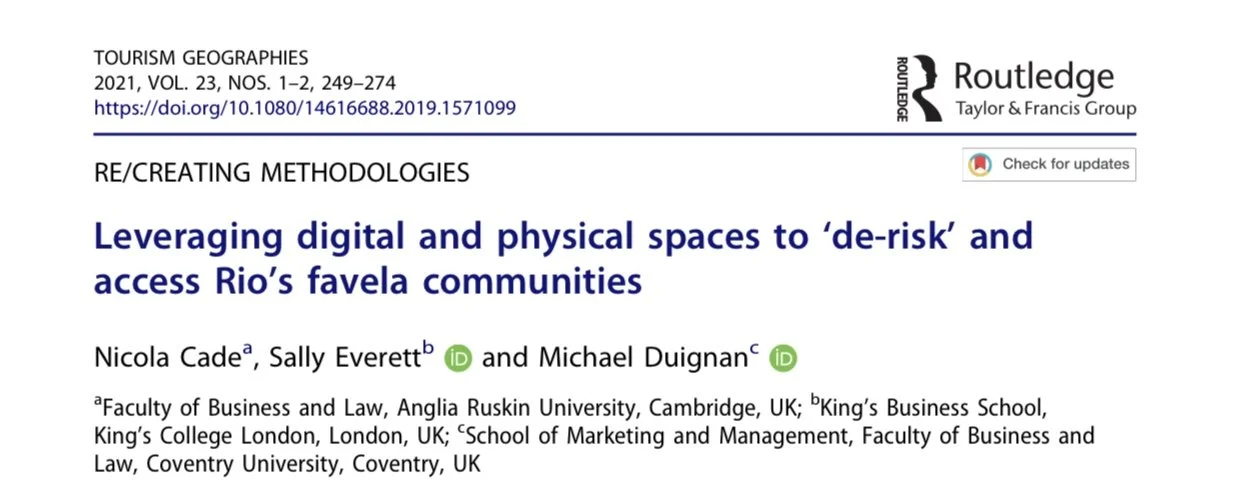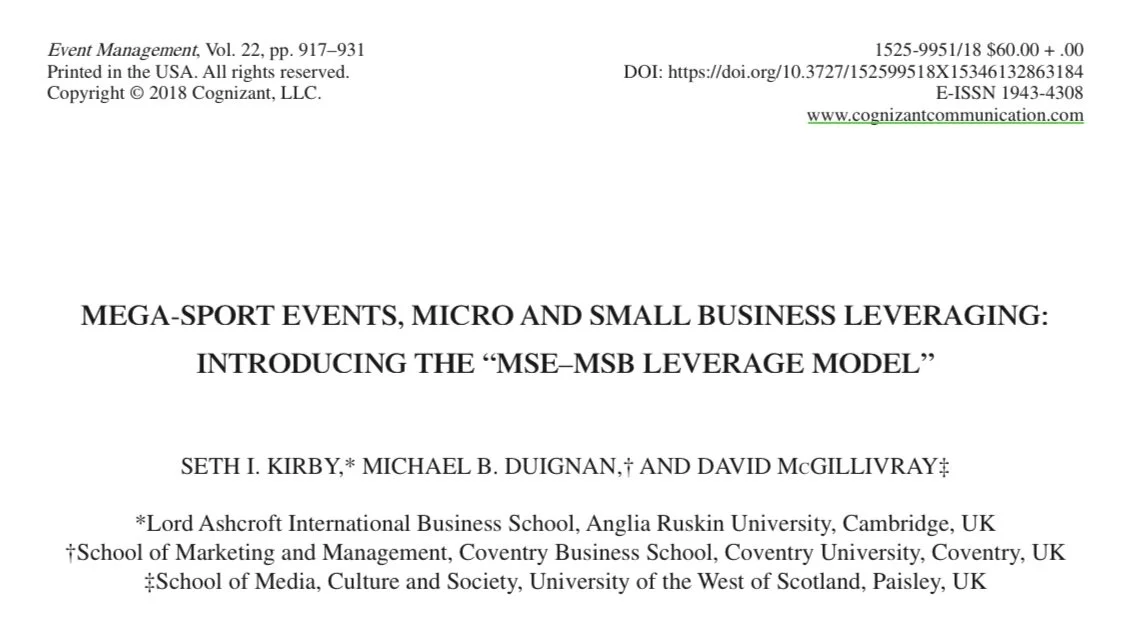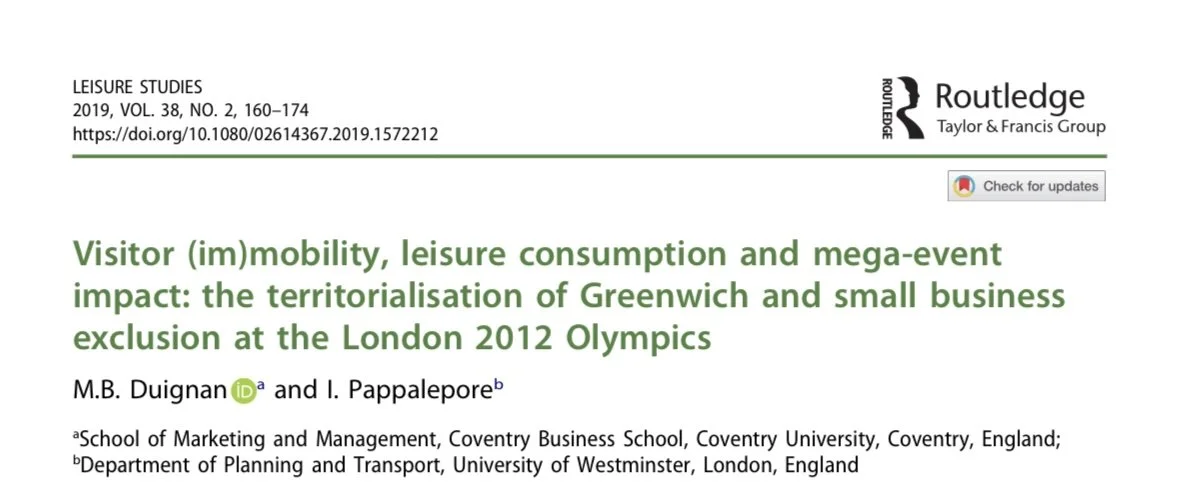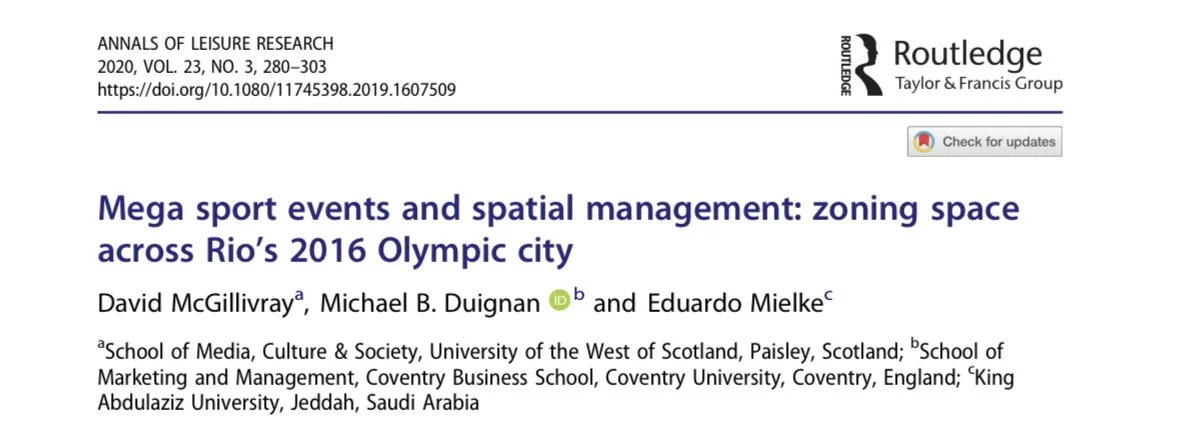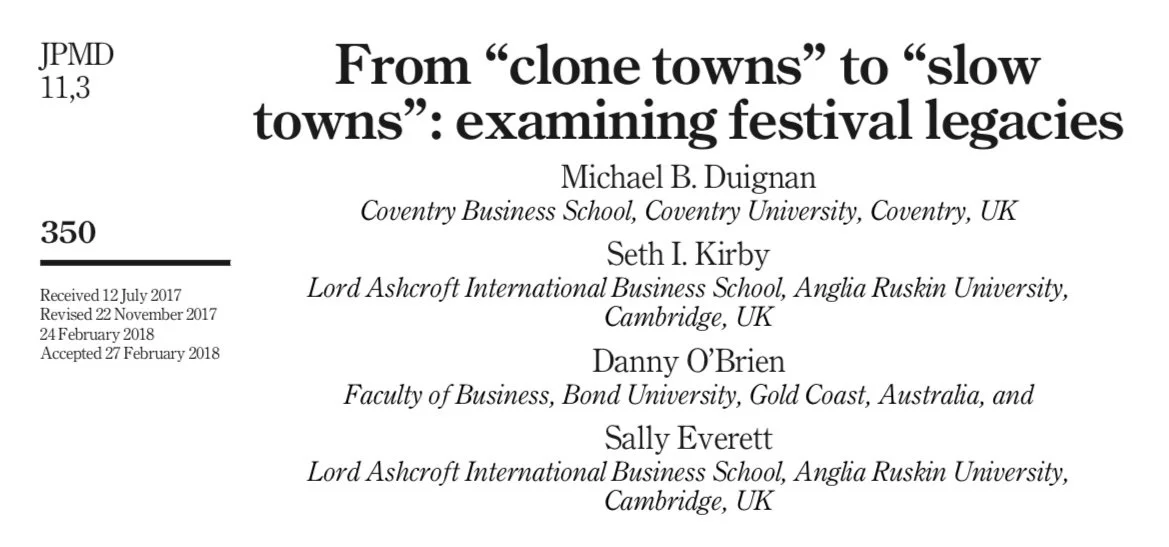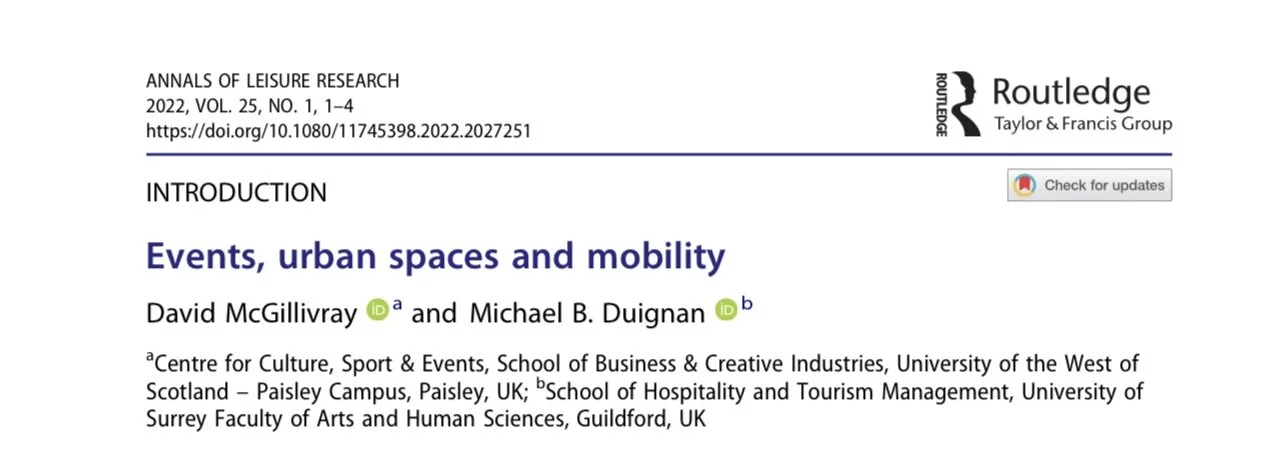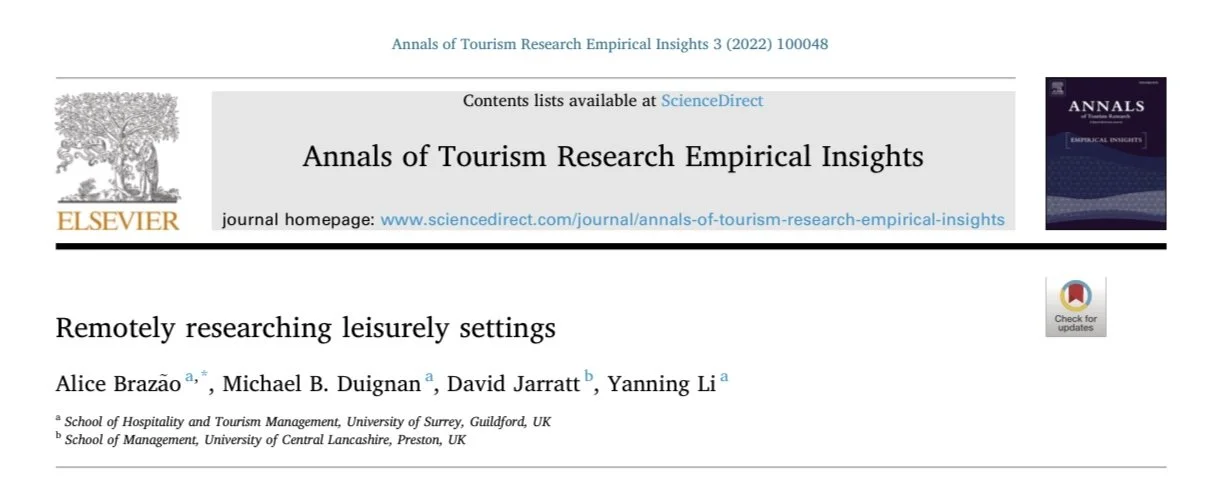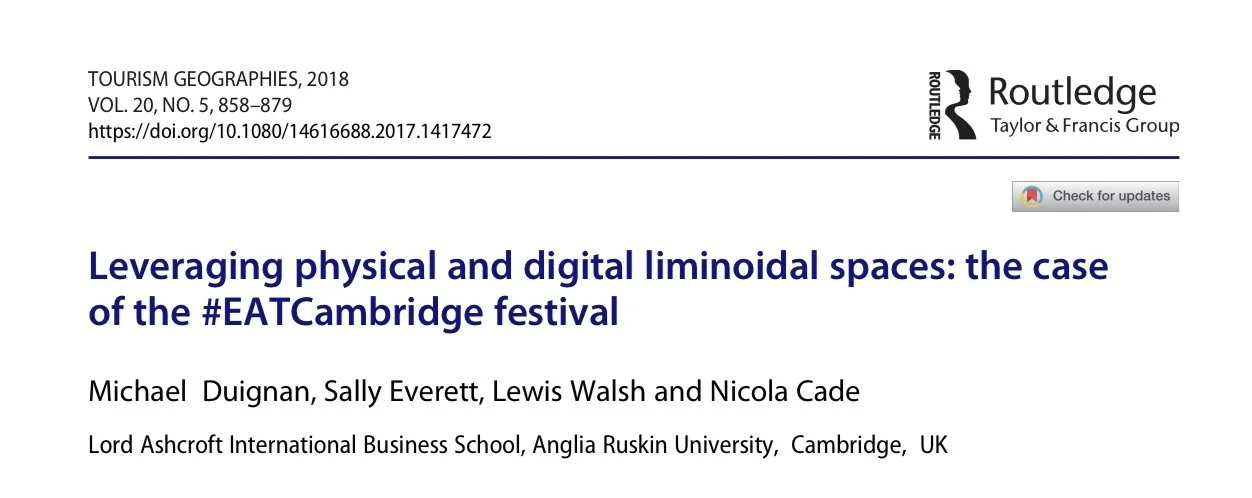ARTICLES
Mike’s portfolio of peer reviewed academic articles published in leading business, events, sports, tourism, AND DEVELOPMENT journals.
-
This work identifies important influencing factors that affect event visitor behaviour in and beyond event zones, utilising a four-year, mixed-method, longitudinal study (n=6212) of the Cambridge Half Marathon (2017–2020). We counter a commonly held view that visitors naturally spill out into local cultural and business precincts, arguing that event zones represent cities within cities that spatially segregate visitors from the host destination; only 7% of the sample engaged in longer and deeper cultural stays. Quantitative data reveals statistically significant demographic and tripographic factors that increase the likelihood of visitors venturing beyond the event zone, whilst qualitative data reveals the behavioural and organisational factors that encourage or discourage engagement. Managerial tactics and strategies for encouraging visitors to venture beyond event zones, across host destinations, to optimise local economic benefits across the host destination are presented.
Visitor behaviour | Determinants | Urban sport events | Event zones | Visitor economy | Host destination | Nudging | Cambridge half marathon
-
Able-bodied, and increasingly people with disabilities, represent a key audience for mega-events; occasions that act as crucibles where social problems endemic to host destinations can be exposed and tackled through targeted social policy. Drawing on the social model of disability, the paper examines how Japan utilised Tokyo 2020 as a field configuring event to disrupt systems of ableist thinking and tackle physical and attitudinal barriers restricting Persons with Disabilities (PwD) to accessible tourism. Qualitative evidence reveals national commitments to relegitimise, improve accessibility for - and acceptance toward - PwD in Japanese society, through transformations to the built environment, national awareness, and educational campaigns in the build up to Tokyo 2020. An over-emphasis on physical as opposed to social structural change mean negative attitudes often persist, where disability remains stigmatised, leading to PwD immobility and social exclusion. Our policy recommendations and managerial implications, alongside research directions attend to this disability-attitude gap.
Accessible tourism | Field configuring events | Social model of disability | People with disabilities | Tokyo 2020
-
Recovering post-Fukushima, Japan utilised Tokyo 2020 to re-image the country as a safe and culturally distinctive destination by deploying creative place-branding initiatives. This paper investigates how and why, by drawing on insights generated via three complimentary methods – (i) 26 in-depth interviews, (ii) a 33-day walking observation, and (iii) policy and media document analysis – offering a unique and detailed case study. Analysis is principally framed around two state-led national and Tokyo-city ‘representational’ innovations deployed: ‘EnjoymyJapan’ and ‘Tokyo, Tokyo’, augmented by ‘functional’ country-wide tourism infrastructure innovations: both playing a critical role for re-imaging Japan. Conceptually, the paper argues how straddling both types of innovation, particularly representational innovation(s) as of late is a key strategic objective and principal reason for hosting: helping to develop, distil and better articulate a place’s cultural identity. Separately, yet relatedly, in addition to recovering post-Fukushima, the paper notes how Japan simultaneously sought to mobilise tourists’ engagement away from busy metropolitan tourist zones, beyond the country’s so-called ‘Golden Route’: a key part of the country’s pledge to United National Sustainable Development ambitions. Finally, more broadly and critically, the article notes how these complex processes are fuelled and enabled by a dual shock: produced by ecological (Fukushima) and economic shock (Tokyo 2020) affording host-culture to be leveraged for re-imaging purposes.
Place branding | Place re-imaging | Representational innovation | Mega-events | Tokyo 2020
-
This commentary examines how events-related research has and increasingly contributes to tourism studies, and how these lines of argument have evolved over the last thirty years, pri- marily in Annals of Tourism Research. I explicate the theoretical features of events, how previ- ous work has conceptualized them, and why events are unique organizational settings to contribute to theory development. This is particularly significant as events are increasingly de- livered in public, cultural and tourist spaces – an extra-territorial shift with implications for the future study and practice of tourism. I close by calling for a more plural conception of events, inclusive of world events, which share similar conceptual features to cultural and sporting events that typically dominate social analysis in event and tourism studies.
Events | Tourism | Conceptualising events | Debates
-
Scholars and practitioners have long been analyzing and evaluating the way events, particularly mega-events, serve as a mechanism of change. Powerful descriptions are typically brought to life via event impact and legacy case studies: yet, I argue such work can remain atheoretical—or—conceptu- ally disorganized. I draw on Bourdieu’s field theory and the management study of Field Configuring Events to develop a new analytical framework: the “Cognitive and Relational Mapping of Field Configuring Events”—offering a set of interrelated concepts to strengthen analysis and conceptual consistency between studies, while providing latitude to overlay different disciplinary perspectives. I detail methodological and conceptual advantages afforded alongside six ways the framework could be applied and extended across various cases and contexts.
Field theory | Field configuring events | Mega-events | Event-led field development
-
Our paper throws new light on how entrepreneurial leverage is achieved in Olympic Transit Zones. Specifically, we investigate: i) contextual features enabling and constraining ‘immediate leveraging’ efforts, ii) tactics deployed to leverage, and iii) how local-entrepreneurs encouraged visitors to connect and interact with localities. We deployed a walking-methodology and inter- views with local-stakeholders during Rio 2016 to do this. Findings indicate that less securitised and regulated Olympic Transit Zones allowed entrepreneurs to leverage spaces they would be typically excluded from, whilst simultaneously producing spaces that encouraged greater dwell- time for visitors to interact with local-culture and traders. We draw on concepts of liminality, liminoidal and communitas to explain these contrary findings and suggest how future events can foster such environments.
Liminality | Liminoidal | Communitas | Entrepreneurial leveraging | Mega-sport events Olympic Transit Zones
-
London 2012 promised local small businesses access to lucrative Olympic event-tourism and visitor trading opportunities. However, as urban spaces were transformed to stage live Games, many local stakeholders found themselves locked out. We focus on one ‘host’ community, Central Greenwich, who emerged negatively im- pacted by such conditions. 43 in-depth interviews and secondary evidence reveal that this was a community determined to resist. Few papers have extended the concept of resistance to the context of mega-events so we examine why communities resisted, and how physical tactics and creative resistance were deployed. Although efforts afforded some access for local businesses - they proved too little, too late. We develop and present a ‘tactics for resistance’ approach, a series of ‘hard’ and ‘soft’ tactics businesses could use to encourage proactive, as opposed to reactive, communal resistance required to protect local interests and afford access to opportunities generated by temporary mega-event visitor economies.
Communal resistance | Exclusion | Tourism
| Small businesses | Hard and soft tactics | Host community | Mega-event | London 2012
-
The aim of this research note is threefold: 1) to introduce the concept of paradox and its numerous applications to the study and management challenges associated with the planning and delivery of events, with a specific look at large-scale events like the Olympics to provide an extreme case; 2) to present a new paradox entitled the “Global–Glocal Paradox” that interrogates how inherent global and local stakeholder interests and tensions are managed; and 3) to present a series of conceptual and practical ways events can “accommodate” as opposed to “resolve” this paradox to help balance stakeholder interests instead of pitting one against the other.
Paradox | Events | Global–Glocal Paradox | Formality vs. informality | Accommodating vs. resolving paradox | Stakeholder interests
-
Rio 2016 sought to connect Olympic-tourists with the city’s local- Cariocan community and culture. Yet the way mega-events are spatially and regulatorily organized, alongside the behavioural tendencies of Olympic-tourists, constrain such ambitions. Using Rio 2016 as a case-study, we offer in-depth, qualitative insights through the lens of 35 individual Olympic-tourists to examine how and why these factors determine behaviour, and thus experiences across host-environments. We detail how concerns over tourists’ safety result in managers designing risk averse experiences, produced by overlaying hyper-securitized and regulatory enforcements inside existing tourist bubbles, creating what we refer to as a ‘double bubble’ – reducing the likelihood of visitors venturing ‘off-the-beaten-track’. Whilst Olympic-bubbles protect tourists from outside threats, they restrict cultural engagement with the wider city, neighbourhoods and locals –side-lining other sides to Rio. We suggest managers adopt a dual- strategy of ‘local infusion’ in and ‘tourist diffusion’ beyond official zones to achieve intended goals.
Olympic tourism | event tourism | tourist bubbles | New urban tourism | Rio 2016
-
Olympic event zones are characterized as being intensely formally regulated during live staging periods, producing exclusionary environments blamed for sidelining host community interests. Yet, our findings contradict what scholars perceive to be inflexible formal regulations, and, the regulator’s ability to take informal action. By interviewing and drawing on the experience of 17 regulators during London 2012 we identify how regulators simultaneously oscillate between modes of regulatory formality and informality, straddling what is referred to as the “formality–informality span.” Our application and theorization of these concepts critiques existing explanations of how regulation is enacted in mega-sporting events, providing new insights into the way organizers balance regulatory demands and potentially opening up new emancipatory policies and more equitable outcomes for host communities.
Regulatory in/formality | Formality–informality | span | Olympic event zones | Host community | Mega-sporting events | London 2012
-
Olympic cities increasingly draw on New Urban Tourism (NUT) principles as part of a host’s strategic tourism development objec- tives. By doing so, governments and event organisers seek to entangle visitors with local urban, cultural and everyday life. Yet, empirical evidence generated across previous Olympic cities illus- trates how hosts often fail to encourage such host–guest inter- activity. This is a critical tourism geography and consumption issue repeatedly identified across host city contexts. To address the disconnect between inbound urban tourists and host com- munities, Tokyo 2020 explicitly placed NUT objectives at the heart of official bid and policy promises. On the basis of a 33-day walk- ing ethnography in Tokyo as well as 26 interviews and documen- tary analysis, our work details a set of strategically planned and creative NUT initiatives deployed by the public, private sector, and host community in the lead up to the Tokyo 2020 Games. Some of these include state-funded walking tours and city volun- teer guide networks; tourist boards promoting local-grassroots festivals; through to joint collaborations between local tourist boards and ‘Timeout’ to produce local guides – constituting a productive step forward for showcasing the local culture outside tourist bubbles. Furthermore, we illustrate how Tokyo’s urban landscape closely intertwines tourist bubbles with local neigh- bourhoods affording a potential balance between staged and spontaneous host–guest interaction. Our conclusions emphasise the conceptual, social, and economic implications for strategic planning and implementation of NUT in Olympic cities and its potential contribution to inclusive and sustainable development.
New urban tourism | strategic leveraging | Olympic cities | tourism development | critical consumption | host community | mega-events | Tokyo 2020
-
This study investigates the impacts of the London 2012 Olympic Games and their related cultural pro- gramme on local small creative organisations in East London. It contributes to unpacking the elusive concept of legacy thorough an in-depth analysis of creative organisations' stories and experiences, combined with an analysis of policy documents and interviews with key informants, over a four-year period (2010e2014). A range of potential impacts of mega-events for creative organisations are identi- fied and systematically discussed. The results highlight a gap between Olympic rhetoric and local reality. Problems include inadequate local consultation, barriers to accessing opportunities and inability to leverage effectively. The study also explores the role of cultural tourism in delivering an Olympic legacy for the local creative industry. It finds that opportunities to showcase deprived e but creative e areas in East London, and foster the development of creative forms of tourism, were missed.
Cultural Olympiad | London 2012 | Event tourism Creative industries | Olympic games
-
The negative impacts of tourism, often associated with overtourism, can lead to resistance by local stakeholders. This study focuses on collective resistance across Japan in the lead up to the Tokyo 2020 Olympics, during a period of exponential growth in tourism that produced dis- ruption and fear, and led to a rise in tourismophobia. We conceptualise negative reactions through Castells' theory of the network society. Utilising qualitative data, we argue that Japan's national tourism growth strategy represented a state-imposed legitimising identity, lead- ing to communal resistance sentiment and tactics across Japan and Tokyo. We illustrate how events act as catalysts for opposition against tourism development and how resistance identi- ties can produce a new project and counter-legitimising identity tourism planners should take seriously.
Collective Identities | Castells' network society | Communal resistance | Overtourism | Mega-events
| Japan
-
This paper reviews progress in the field of urban tourism, revisiting and challenging the validity of the paradoxes presented in the paper by Ashworth and Page (2011). To do this, the paper examines the expansion of research endeavours in urban tourism in relation to these paradoxes, including the outputs in dedicated journals on city tourism along with the wider range of outputs generated since 2011 in social science. It also revisits the initial proposition set out regarding an imbalance in attention in urban tourism research (Ashworth 1989, 2003) and how this has been addressed through a broader development of thinking at the intersection of urbanism and tourism. It is a selective review of progress in the field, highlighting the challenges of deriving theory from western modes of analysis that need re-thinking in relation to the global south, notably Africa as well as developments in Asia and the Middle East.
Urbanism | Urban Tourism | Paradoxes | Urban Studies | Events | Global South
-
Rio 2016 sought to connect Olympic-tourists with the city’s local- Cariocan community and culture. Yet the way mega-events are spatially and regulatorily organized, alongside the behavioural tendencies of Olympic-tourists, constrain such ambitions. Using Rio 2016 as a case-study, we offer in-depth, qualitative insights through the lens of 35 individual Olympic-tourists to examine how and why these factors determine behaviour, and thus experiences across host-environments. We detail how concerns over tourists’ safety result in managers designing risk averse experiences, produced by overlaying hyper-securitized and regulatory enforcements inside existing tourist bubbles, creating what we refer to as a ‘double bubble’ – reducing the likelihood of visitors venturing ‘off-the-beaten-track’. Whilst Olympic-bubbles protect tourists from outside threats, they restrict cultural engagement with the wider city, neighbourhoods and locals –side-lining other sides to Rio. We suggest managers adopt a dual- strategy of ‘local infusion’ in and ‘tourist diffusion’ beyond official zones to achieve intended goals.
Walking methodology | Digital platforms | Spatial-urban processes | Host community inclusion | Rio 2016
-
We investigate the live staging spatial-organisational requirements of the Rio 2016 Olympic Games, exploring the extent to which the project sequestrated, territorialised and commodified public space. Relatedly, we examine the role of new legal, regulatory and securitised event conditions in affording an effective and efficient ‘Olympic takeover’. We do this by drawing on i) official Rio 2016 planning documents, ii) obser- vations of the live Olympic-city spatial effects, and iii) interviews with key informants. Findings reveal that Rio’s specially created Olympic event zones sought to transform visitor flows and circulations across the city, appropriating and regulating public space in-line with a desired tourist aesthetic. Rio’s public civic space became reimagined and controlled for commercial exploitation by Olympic sponsors, supporters and suppliers– facilitated by the creation of areas of exclusivity. And yet, we also reveal how the Rio Olympic city simultaneously emerged disorganised, open and fluid in places– a (temporary) break in the (neoliberal) economic logic we have come to expect. We argue that localised conditions affecting Rio afforded closer connectivity between event visitor econo- mies and host communities. While these gains remain marginal and largely symbolic, they demonstrate that with effective planning, the Olympic host city need not only serve corporate interests.
Mega sport events | Urban space | Spatial territorialisation | | Rio 2016 | Exceptional legislation | Visitor economy
-
Building relationships of trust and mutual understanding between researcher(s), local stakeholder(s) and gatekeeper(s) is widely regarded as a critical factor in successful research. Methodological strategies and tactics are often based on contextual variability and accessing some communities presents a harder and riskier proposition than others. Here we propose an empirically driven and holistic methodological approach for accessing high-risk com- munities whereby deprivation and criminality characterises every- day living. Following the ‘legacy’ of both the 2014 FIFA World Cup and Rio 2016 Olympics, this paper charts a research journey by detailing how local perspectives were accessed at the heart of one urban favela in Rio: Morro dos Prazeres. The methodological framework is underpinned by leveraging social networks to aid the identification of key stakeholders required to access and bridge the void between researcher(s) and community. Furthermore, creative digital and physical access routes were also employed (including social messaging platforms such as ‘WhatsApp’) which helped build and maintain trust with highly respected community leaders before, during and after the research. We suggest that our pro- posed ‘Digi-cal model’ (reflecting the digital and physical nexus) approach is transferable to similar tourism projects that require sensitive approaches and complex stakeholder navigation in ‘high- risk’ community settings.
Trust | Access | Gatekeepers | De-risking research | Host community | Social networks | Digital methodologies | Rio
-
Micro and small business (MSB) interests legitimize mega-sport event (MSE) candidature bids. Yet, MSB interests can be sidelined in the event lead up, live staging, and legacy periods. This article provides a detailed: 1) review of MSE impacts on existing MSBs residing within targeted host communities, 2) conceptual and practical examination of MSE leveraging opportunities, 3) synthesis of good inclusionary practices identified in previous MSE case studies. As a result, a series of general and specific ways MSEs can foster MSB leveraging and legitimize local interests are suggested. We present a comprehensive analysis of key works since mid-1990s related to the themes identified above. Our analysis identifies that there is limited conceptual and empirical research on MSB impact and leveraging activities in the context of MSEs, yet significant evidence points to negative experiences, disruption, and displacement effects on residential (host) communities. We purposively focus on good practice in the context of other MSEs from the Olympics Games (e.g., London 2012, Rio 2016) and FIFA World Cup (e.g., South Africa, 2010) to inform recommendations and manage- rial implications. We outline a systematic series of ways MSBs can be structurally excluded from accessing MSE leveraging opportunities. Building on Chalip’s widely adopted event leverage model (ELM), we present the “MSE–MSB Leverage Model” to illustrate how MSEs can (re)position MSBs as legitimate stakeholders to support greater leveraging opportunities and better (re)distribute event benefits back into host communities across planning and delivery stages. These range from reconfig- uring: 1) event planning principles and policies, 2) regulatory and trading environments, and 3) the development of MSB business-to-business networks and partnerships.
Host community | Mega-sport events | Micro and small business | Leveraging | Event management | Event planning and policy
-
Focusing on the London 2012 Olympics, we investigate the impact of mega- sport events’ spatial transformations on visitor mobility, local leisure con- sumption and resulting small business trade. Our case study draws on 43 in-depth interviews with local authorities, governmental and non-govern- mental project actors, and small-local leisure and visitor economy businesses (retail and hospitality) located at the heart of a ‘Host Event Zone’ in Greenwich, London. We supplement subjective accounts with a documentary analysis of policy reports, media, and archival material as the basis for our empirical analysis. Our findings reveal a major dichotomy between the ‘rhetoric’ of inclusion and local ‘realities’ of exclusion as security planning and spatial controls served to close off public spaces and local attractions: diverting visitor flows and leisure consumption towards official event sites, away from local businesses. We illustrate how such urban processes effectively render a vibrant business community invisible and visitors immobile to explore local commu- nity spaces during the live staging periods. We close with implications for event organisers, managers and policymakers focused on re-configuring the socio-spatial elements of Olympic organisation and re-direct and mobilise visitor economy flows towards more open civic and leisure spaces in the hope of better (re)distributing consumption into host communities.
Tourist mobility | Visitor economy | Business leveraging | Event impacts | Host community | London 2012
-
Hosting the Olympic Games demands the efficient and effective sequestration of public space across the city to stage official sports, cultural, and commercial activities. Specifically, this paper examines how fast-tracked urban development processes create exclusive, commercial enclaves to maximize leverageable benefits for external actors. We focus on the case of Rio 2016, drawing on: (i) observations across the city and event zones, including Live Site, Last Mile, and transit spaces, (ii) interviews with key event, policy and visitor economy stakeholders, (iii) documentary analysis of Rio’s plans and promises outlined in official bid documentation, and (iv) supplementary sources documenting Olympic planning effects. Our findings illustrate how the legal power of the Host City Contract and highly-circumscribed Olympic regulations create the conditions for managing urban space that enables the circulation of visitor flows to – and the containment of consumption within – newly privatized, temporarily constructed urban zones that favour global interests.
Mega sport events | Spatial management | Visitor economy | Event zones | Visitor circulation and containment | Rio 2016
-
Purpose – This paper aims to examine the role of grassroots (food) festivals for supporting the sustainability of micro and small producers, whilst exploring potential productive linkages between both stakeholders (festivals and producers) for enhancing a more authentic cultural offering and destination image in the visitor economy.
Design/methodology/approach – This paper is exploratory, qualitative and inductive. Evidence is underpinned by a purposive sample, drawing on ten in-depth interviews and 17 open-ended survey responses collected across 2014 and 2015 – drawing perspectives from traders participating in the EAT Cambridge festival.
Findings – This paper unpacks a series of serendipitous [as opposed to “strategic”] forms of festival and producer leveraging; strengthening B2C relationships and stimulating business to business networking and creative entrepreneurial collaborations. Positive emergent “embryonic” forms of event legacy are identified that support the longer-term sustainability of local producers and contribute towards an alternative idea of place and destination, more vibrant and authentic connectivity with localities and slower visitor experiences.
Originality/value – This study emphasises the importance of local bottom-up forms of “serendipitous leverage” for enhancing positive emergent “embryonic” legacies that advance “slow” tourism and local food agendas. In turn, this enhances the cultural offering and delivers longer-term sustainability for small local producers – particularly vital in the era of “Clone Town” threats and effects. The paper applies Chalip’s (2004) event leverage model to the empirical setting of EAT Cambridge and conceptually advances the framework by integrating “digital” forms of leverage.
Legacy | Leveraging | Business collaborations | Grassroots festivals | Micro and small producers | Slow tourism
-
Purpose – London’s Candidature bid projected an irresistible legacy of lasting benefits for host communities and small businesses. Yet, local post-Games perspectives paint a contrasted picture – one of becoming displaced. This paper aims to draw on event legacy, specifically in relation to rising rents, threats to small business sustainability and impact on place development by empirically examining London’s local embryonic legacies forming across one ex-hosting Olympic community: Central Greenwich.
Design/methodology/approach – In total, 43 interviews with local businesses (specifically, small retailers and hospitality businesses), local authorities, London-centric and national project actors and policymakers underpin analysis, supported by official London 2012 archival, documentary and media reports, were conducted to add texture and triangulate primary and secondary data sources.
Findings – Juxtaposing ex ante projections vs emerging ex post realities, this paper reveals a local legacy of small business failure fuelled by rising commercial rents and a wider indifference for protecting diverse urban high streets. Embroiled in a struggle to survive, and barely recognised as a key stakeholder and contributor to legacy, small businesses have and continue to become succeeded by a new business demographic in town: monochromatic global and national chains. Typifying the pervasive shift toward clone town spaces, this article argues that corporate colonisation displaces independent businesses, serves to homogenise town centres, dilute place-based cultural offer and simultaneously stunts access to a positive local development legacy. This paper argues that such processes lead to the production of urban blandscapes that may hamper destination competitiveness.
Originality/value – Examining event legacy, specifically local legacies forming across ex-host Olympic communities, is a latent, under-researched but vital and critical aspect of scholarship. Most event legacy analysis focuses on longer-term issues for residents, yet little research focuses on both local placed-based development challenges and small business sustainability and survival post-Games. More specifically, little research examines the potential relationship between event-led gentrification, associated rising rents and aforementioned clone town problematic. Revealing and amplifying the idiosyncratic local challenges generated through an in-depth empirically driven triangulation of key local business, policy, governmental and non-governmental perspectives, is a central contribution of this article missing from extant literatures. This paper considers different ways those responsible for event legacy, place managers and developers can combat such aforementioned post-Games challenges.
Legacy | Clone towns | Host community | Place development | Small business sustainability | Mega events
-
This special issue seeks to critically examine the relationship between events, urban spaces and mobility. Specifically, it seeks to explore how and why events enable and/or produce new spatial (re)configurations when staged and how these changes influence mobility, exploration, engagement and/or consumption across host environments – whether at an international, national, regional, city and/or community level. Events, irrespective of their size and composition, influence the way people move, explore, engage with and/or consume the urban environments that stage them (Giulianotti et al. 2015; Mhanna, Blake, and Jones 2017). They are often managed in private venues, yet are increasingly staged in public spaces like street, squares and parks (Smith 2016). Utilizing urban public spaces to house events, whether a beach, park or plaza, often requires temporary urban rearrangements, producing what are sometimes referred to as ‘Host Event Zones’ (HEZs). These are temporary designated areas where event acti- vation activities take place (McGillivray, Duignan, and Mielke 2020). Sometimes HEZs are public and open to all, other times they are private and closed, requiring a ticket to access and the rights of sponsors and other commercial actors being protected by excep- tional planning regulations. Beyond the demarcated boundaries of HEZs, events also extend their territorial presence and reach in a number of creative ways, including the emergence of ‘fringe spaces’. For example, food festivals have sought to engage periph- erally located restaurants as a way to move visitors out of central urban areas (Duignan et al. 2017). In contrast, mega sport event organizers create strategically located ‘live sites’ and ‘fan parks’ to house non-sporting cultural and commercial activity, deploying tactics to circulate visitors to and contain them within global spaces of consumption (Armstrong, Giulianotti, and Hobbs 2017).
Events | Urban Spaces | Mobility
-
Identifying creative ways to collect data remotely has and continues to be embraced by researchers, primarily influenced by three factors. First, travel restrictions imposed due to, for example, political instability, war, security concerns, infections, and pandemics, including the most recent COVID-19 global lockdown. These conditions make physically collecting data difficult or impossible. Second, environmental concerns, particularly those around the need to reduce travel-related carbon emissions, both directly and in-directly, places pressures on limiting travel (Doran, Pallensen, Bohm, & Ogunbode, 2021). Third, the availability of online data sets, for example large quantitative big data sets to rich qualitative social media data, inclusive of text, still and video imagery is increasing in popularity and use. Together, incorporating remote methods can help researchers overcome logistical, financial, geographical and cultural barriers. They can also increase the volume and enhance the variety, velocity, veracity and therefore value of one’s analysis and information achieved by fusing data sets for triangulation purposes.
Remote methods | Digital ethnography | Walking ethnography | Event tourism studies | Netnography
-
This paper conceptualises the way physical and digital spaces associated with festivals are being harnessed to create new spaces of consumption. It focuses on the ways local food businesses leverage opportunities in the tourist-historic city of Cambridge. Data from a survey of 28 food producers (in 2014) followed by 35 in- depth interviews at the EAT Cambridge food festival (in 2015) are used to explain how local producers overcome the challenges of physical peripherality and why they use social media to help support them challenges restrictive political and economic structures. We present a new conceptual framework which suggests the development of place through food festivals in heritage cities can be understood by pulling together the concepts of ‘event leveraging’, ‘liminoid spaces’ (physical and digital) and modes of ‘creative resistance’ which helps the survival of small producers against inner city gentrification and economically enforced peripherality.
Liminoid spaces | Social media | Creative resistance | Food festivals | Cambridge | Event leveraging
COMING SOON: HOW CAN MAJOR EVENTS BE LEVERAGED TO EDUCATE VISITORS ABOUT EVERYDAY AND ENDEMIC SOCIAL CHALLENGES
-
Our research examines how and why major events can be utilized as platforms for educational programming aimed at citizens in – and domestic and international visitors to – host destinations. We analyzed ten years of It’s a Penalty’s campaign data (2012 – 2022) to identify how educational touchpoints were deployed at strategic locations (airports, airlines, rideshares and taxis, hotels, stadia, media, and social media), working with celebrities, elite athletes, and strategic partners like Airbnb and Uber to raise awareness and help tackle human trafficking and modern-day slavery at thirteen major events; FIFA World Cup to the Super Bowl, Brazil to Japan. Findings reveal a nuanced approach for each case reflective of the contextual setting, which are then synthesized into a general model to help future events optimize the educational value of staging major events. We theorize that the visitor’s journey to and across host destinations represent both a liminal and liminoidal “rite of passage” – a system of transit zones, event zones, ancillary and transitionary spaces with educational touchpoints designed to transform one’s attitude and actions toward tackling event-induced and everyday social injustices.
Educational programming | Social injustice | Events | Human trafficking | Liminoidal | Rite of passage
COMING SOON: A Theoretical Framework of Communal Resistance to Mega-Events
-
Activists resist events in diverse ways to address many social problems. We synthesise 20 years of academic literature and data on how and why activists have opposed the bidding, staging, and legacy fallout of the Summer and Winter Olympic Games, providing a comprehensive overview of Olympic resistance. Evidence is presented from a transnational resistance movement perspective and through case-by-case analysis of international events, including historical cases (Beijing 2008; Vancouver 2010; London 2012; Sochi 2014; Rio 2016; PyeongChang 2018; Tokyo 2020; Beijing 2022) and current cases (Paris 2024; LA 2028). Findings reveal a typology of resistance approaches. We explain their importance for each case, detailing key stakeholders, their roles in resistance, where it occurs, and when it emerges. Based on this analysis, we present a theoretical framework of communal resistance to large-scale events, generalisable to contested major sporting and cultural contexts. We conclude with managerial recommendations and a future research agenda, focused on exploring resistance beyond Olympic contexts; effectiveness of resistance tactics; and how transnational networks form, operate, influence policy and planning in an increasingly digitised world.
Communal resistance | Tactics | Large-scale events | Olympics
